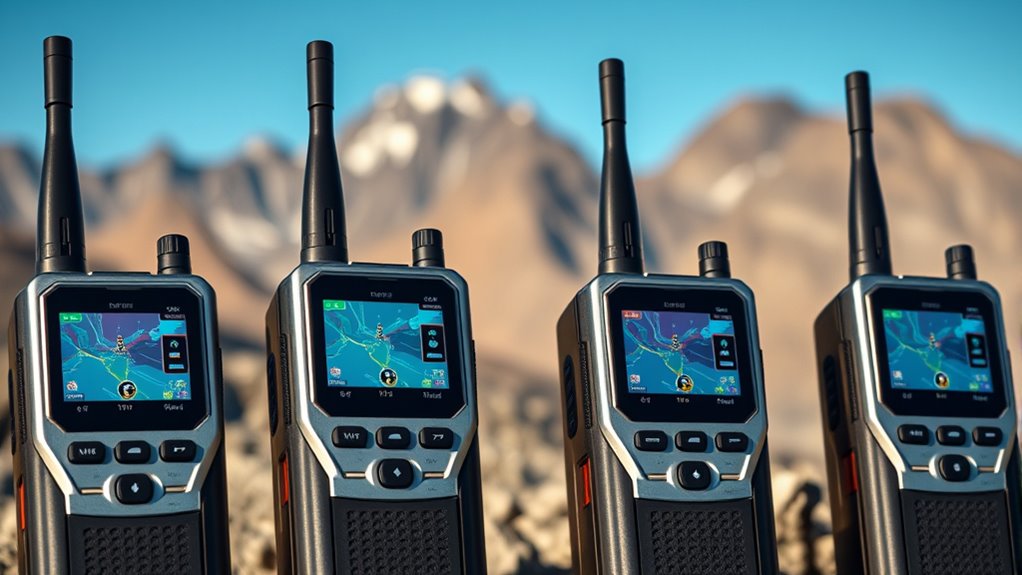If you’re looking for the 15 best satellite communicators for reliable connectivity in 2025, I recommend considering models like Garmin inReach Mini 2, ZOLEO, Spot Gen 4, and OffGrid solutions. These devices are rugged, offer reliable two-way messaging, emergency SOS, GPS navigation, and long battery life—perfect for outdoor adventures and remote work. To find the ideal fit for your needs and environment, you’ll want to explore features, durability, and subscription options, which I’ll clarify as you explore further.
Key Takeaways
- Prioritize devices with reliable global satellite coverage (Iridium, Globalstar) and proven connectivity in remote areas.
- Consider rugged, waterproof models with long battery life suited for extended outdoor adventures.
- Look for user-friendly interfaces, quick activation, and emergency SOS features for safety and ease of use.
- Evaluate subscription plan costs, message allowances, and additional features like offline maps and GPS tracking.
- Choose versatile models compatible with smartphones via Bluetooth or Wi-Fi for seamless communication.
ZOLEO Satellite Communicator, Global SOS & GPS Accessory

If you’re looking for a reliable satellite communicator that keeps you connected in the most remote areas, the ZOLEO Satellite Communicator is an excellent choice. It offers two-way messaging via satellite, cellular, or Wi-Fi, with a dedicated SMS number and email for direct contact. The device supports unlimited check-ins, GPS location sharing, and optional waypoint sharing. Built to withstand tough conditions, it’s IP68-rated, rugged, and lightweight, with over 200 hours of battery life. Its user-friendly design, compatibility with iOS and Android, and emergency SOS alerts ensure you stay safe and connected no matter where your adventures take you.
Best For: outdoor enthusiasts, hikers, and adventurers who need reliable global communication and emergency support in remote areas.
Pros:
- Two-way messaging via satellite, cellular, or Wi-Fi for versatile connectivity
- Rugged IP68-rated design with over 200 hours of battery life for durability and extended use
- Easy to use with smartphone compatibility, quick setup, and reliable SOS alerting
Cons:
- Some users wish for more included messages in basic subscription plans
- Additional features like waypoint sharing require optional add-ons, increasing overall cost
- The device may be less effective in extremely dense environments where satellite signals are obstructed
Garmin inReach Mini 2 Satellite Communicator

The Garmin inReach Mini 2 stands out as an ideal choice for outdoor enthusiasts who need reliable, compact communication in remote areas. It’s lightweight, water-resistant, and packed with features like two-way messaging, interactive SOS, and global location sharing—subscription required. Bluetooth connectivity allows seamless pairing with Garmin devices and smartphones via the Explore app for trip planning and navigation. With a battery life of up to 14 days in tracking mode, it’s perfect for wilderness adventures. Though it lacks detailed maps, its breadcrumb feature helps backtrack, and the device’s ease of use and safety functions make it a dependable companion for outdoor exploration.
Best For: outdoor enthusiasts seeking a lightweight, reliable satellite communicator for remote adventures and safety assurance.
Pros:
- Compact, lightweight design ideal for portability during outdoor activities
- Reliable two-way messaging and interactive SOS for safety in remote areas
- Long battery life of up to 14 days in tracking mode
Cons:
- Requires a subscription plan, which can be costly and add ongoing expenses
- Lacks detailed onboard maps, limiting navigation options to waypoints and breadcrumbs
- Setup and activation can be time-consuming and may involve confusing instructions
Garmin inReach Messenger Handheld Satellite Communicator
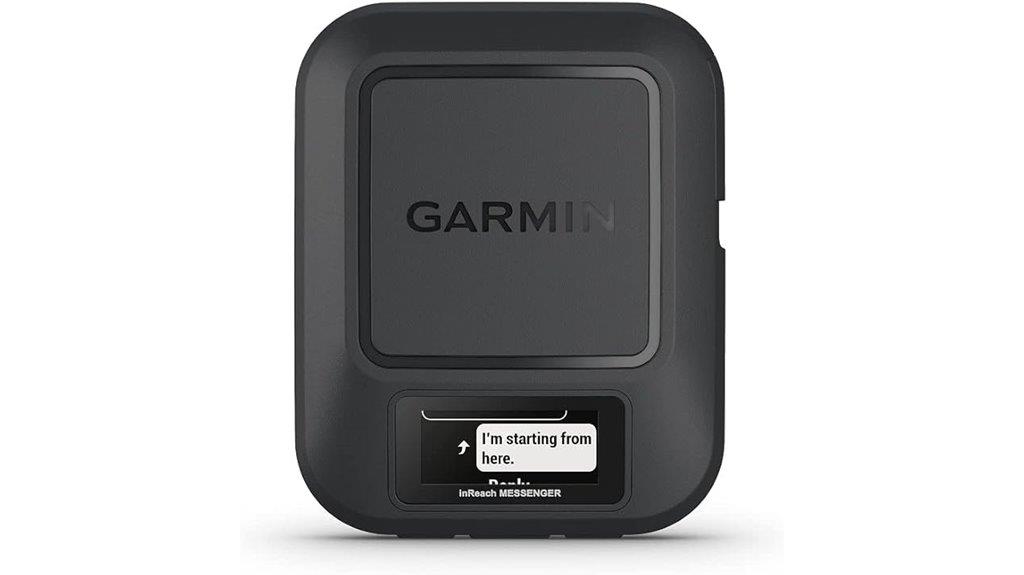
The Garmin inReach Messenger Handheld Satellite Communicator stands out for anyone who needs a compact, reliable device for global two-way messaging and emergency SOS in remote areas. Weighing just 4 ounces and measuring 3.1 x 2.5 x 0.9 inches, it’s built tough for outdoor adventures like hiking, fishing, or hunting. It offers seamless switching between Wi-Fi, cellular, and satellite networks, ensuring reliable connectivity. With a user-friendly display, safety features like SOS alerts, weather forecasts, and location sharing, and up to 28 days of battery life in tracking mode, this device keeps you connected and safe wherever you go.
Best For: outdoor enthusiasts and adventurers who need reliable global communication and emergency assistance in remote areas.
Pros:
- Compact, lightweight, and rugged design ideal for outdoor use
- Seamless switching between Wi-Fi, cellular, and satellite networks for reliable connectivity
- Up to 28 days of battery life in tracking mode, supporting long adventures
Cons:
- Small display size may limit message readability and ease of use
- Requires an active satellite subscription, which adds ongoing costs
- Battery performance can vary depending on usage, potentially limiting device lifespan during extended trips
ZOLEO Satellite Communicator – Global SMS & Email, Emergency SOS, GPS – Android/iOS Accessory
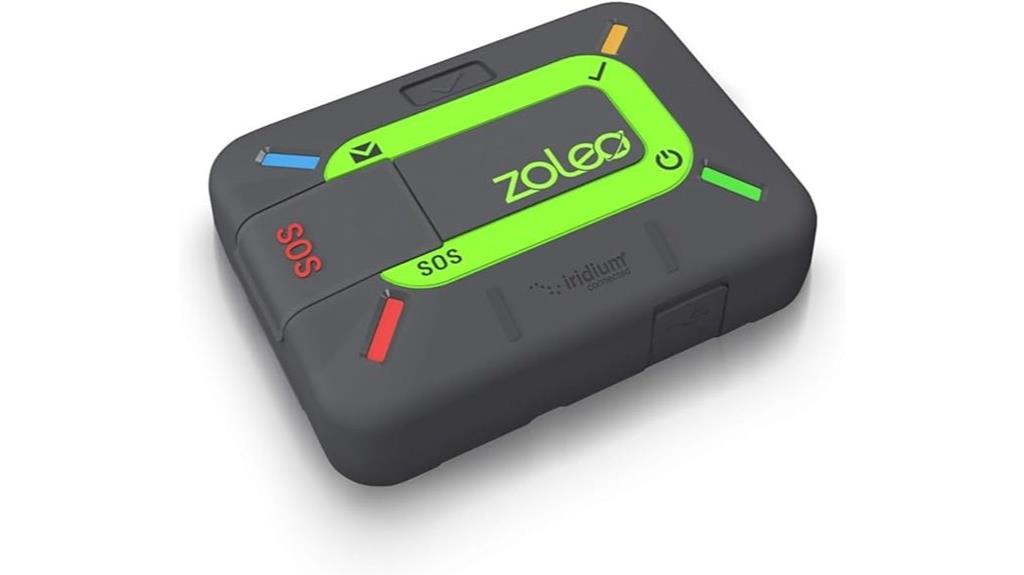
For outdoor enthusiasts and travelers venturing into remote areas, the ZOLEO Satellite Communicator stands out as an essential tool. It offers reliable global messaging via satellite, cellular, or Wi-Fi, supporting SMS, email, and emergency SOS alerts with 24/7 monitoring. The rugged IP68 build and over 200 hours of battery life guarantee durability and long-lasting performance in tough environments. Compatible with Android and iOS, it provides GPS location sharing, waypoint exchange, and check-ins, keeping you connected and safe off-grid. Its portability, ease of use, and flexible subscription plans make it a top choice for remote adventures and safety-conscious users alike.
Best For: outdoor enthusiasts, travelers, and safety-conscious users who need reliable global messaging and emergency communication in remote areas.
Pros:
- Reliable two-way messaging via satellite, cellular, or Wi-Fi networks for versatile connectivity.
- Rugged IP68-rated build with over 200 hours of battery life ensures durability and long-lasting performance in tough environments.
- Compatible with Android and iOS, offering GPS sharing, check-ins, and emergency SOS alerts for comprehensive safety.
Cons:
- Requires a monthly subscription plan, which may be costly for infrequent users.
- As a refurbished product, some users might have concerns about longevity or warranty limitations.
- Limited market presence compared to more established GPS devices, potentially affecting availability and support.
Garmin inReach SE+, Handheld Satellite Communicator with GPS Navigation
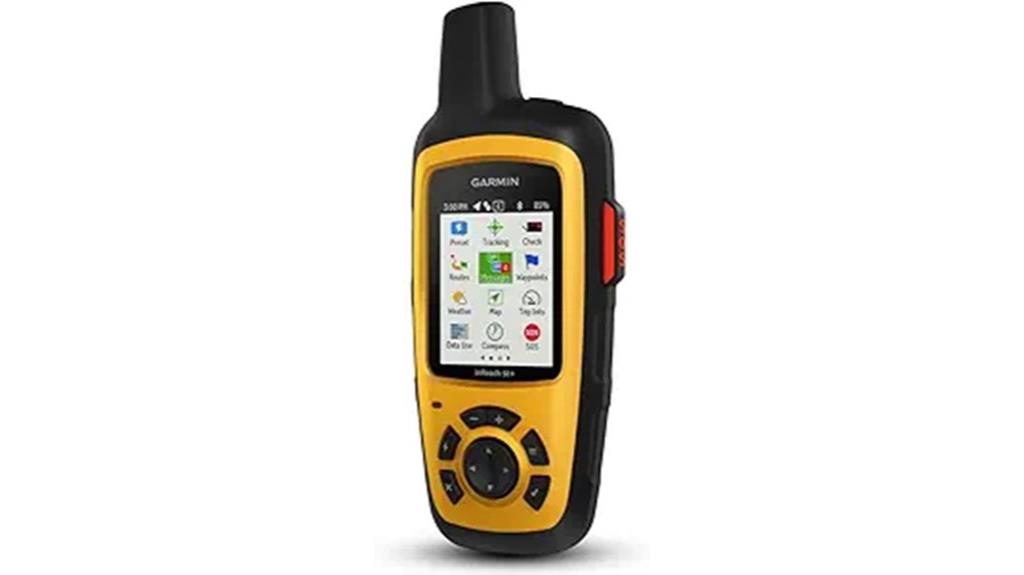
If you’re searching for a reliable handheld satellite communicator that combines GPS navigation with global coverage, Garmin inReach SE+ stands out as an excellent choice. It offers 100% Iridium satellite coverage for two-way messaging, emergency SOS, and location sharing. The device features a color TFT display, GPS tracking, waypoint management, and preloaded topo maps with onboard routing in the Explorer+ model. It’s rugged, lightweight, and has a battery life of about a week. Pairing with the Earthmate app accessibly reveals detailed maps and NOAA charts. Perfect for outdoor adventures, it provides dependable communication and navigation even in remote areas.
Best For: outdoor enthusiasts, adventurers, and remote travelers needing reliable satellite communication and basic GPS navigation in areas without cellular coverage.
Pros:
- Offers global Iridium satellite coverage for dependable two-way messaging and emergency SOS.
- Rugged and lightweight design suitable for outdoor use with a long battery life of about a week.
- Supports pairing with the Earthmate app for access to detailed maps, NOAA charts, and aerial imagery.
Cons:
- Not a full-featured navigation device; detailed maps and high-resolution navigation require additional apps or devices.
- Messaging can be slow and cumbersome due to on-screen keyboard navigation.
- Tracking and location sharing may incur additional costs based on data points and subscription plans.
Motorola Defy Satellite Link Rugged GPS Communicator

Anyone venturing into remote or rugged terrain will appreciate the Motorola Defy Satellite Link’s rugged design and reliable satellite connectivity. This compact device transforms your smartphone into a satellite-enabled communicator via Bluetooth, supporting iOS 14+ and Android 10+. It offers fast 2-way messaging, emergency SOS alerts, and global SMS, even in challenging environments like dense forests or remote lakes. With a durable build, 4-5 days of battery life, and an affordable starting plan, it’s ideal for off-grid adventures. However, coverage can be limited by terrain or dense canopy, and messaging restrictions may affect longer communications. Overall, it’s a solid choice for reliable, rugged satellite connectivity.
Best For: outdoor enthusiasts and adventurers seeking reliable satellite communication in remote, rugged terrains with rugged device durability and straightforward messaging.
Pros:
- Rugged, durable design suitable for harsh environments
- Reliable 2-way satellite messaging with fast delivery
- Long battery life of 4-5 days with moderate use
Cons:
- Limited satellite coverage in dense canopies or high mountain areas
- Messaging character restrictions may limit longer communications
- Support services and plan flexibility can be inconsistent
Spot X with Bluetooth 2-Way Satellite Messenger
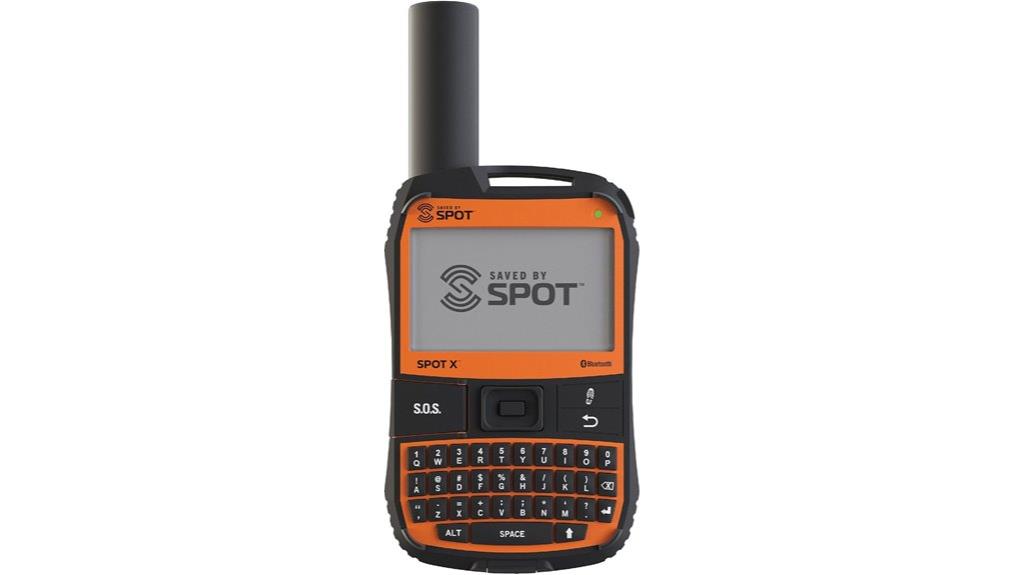
The Spot X with Bluetooth 2-Way Satellite Messenger stands out as an ideal choice for outdoor enthusiasts and adventurers who need reliable communication in remote areas. It offers SOS protection, global coverage via the Globalstar network, and Bluetooth syncing with your phone for seamless messaging and rescue coordination. The device is portable, weatherproof, and GPS-enabled, sharing precise location info with contacts or emergency services. With a dedicated US mobile number, it functions independently or alongside your phone. Its compact design, included accessories, and user-friendly apps make it perfect for hiking, camping, or off-grid travel—though it can struggle in 5G zones and exposed to water or extreme conditions.
Best For: outdoor enthusiasts, hikers, and travelers needing reliable satellite communication and emergency SOS in remote or off-grid locations.
Pros:
- Global coverage via the Globalstar satellite network ensures connectivity in remote areas
- Bluetooth syncing allows seamless messaging and rescue coordination with smartphones
- Compact, weatherproof design with GPS technology for precise location sharing
Cons:
- Struggles with message reception and confirmation in 5G network areas, leading to potential delays
- Difficulties canceling SOS alerts in certain environments, which may cause safety concerns
- Limited durability after exposure to water or extreme conditions, raising questions about long-term reliability
ACR Bivy Stick Satellite Communicator
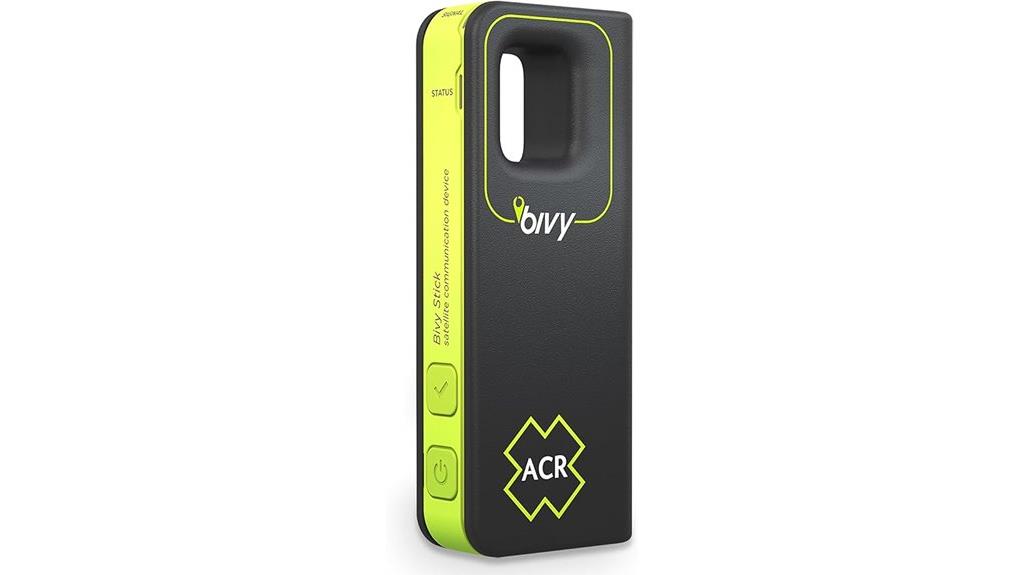
The ACR Bivy Stick Satellite Communicator stands out as an affordable yet reliable option for outdoor enthusiasts who need dependable global connectivity. It offers Iridium satellite coverage for SMS, email, GPS tracking, maps, SOS alerts, weather, and location sharing. Compatible with iOS and Android, it requires a subscription plan, with options for monthly or annual billing. Its off-grid navigation features include offline maps, GPS, and group tracking for up to 12 users. Compact and waterproof, it’s easy to carry and use in remote areas. While some users face activation or device issues, overall, it delivers solid off-grid communication and peace of mind during adventures.
Best For: outdoor enthusiasts, travelers, and guides seeking reliable off-grid communication and safety features in remote areas.
Pros:
- Provides global Iridium satellite coverage for reliable messaging and tracking.
- Compact, waterproof design ideal for outdoor activities and rugged environments.
- Supports group tracking for up to 12 users and offers off-grid navigation with offline maps.
Cons:
- Activation and subscription setup can be complex and challenging for some users.
- Occasionally reports of device malfunctions or false SOS signals.
- Signal strength depends on clear sky view, which may limit performance in dense cover or poor weather.
Garmin inReach Mini 2 Satellite Communicator
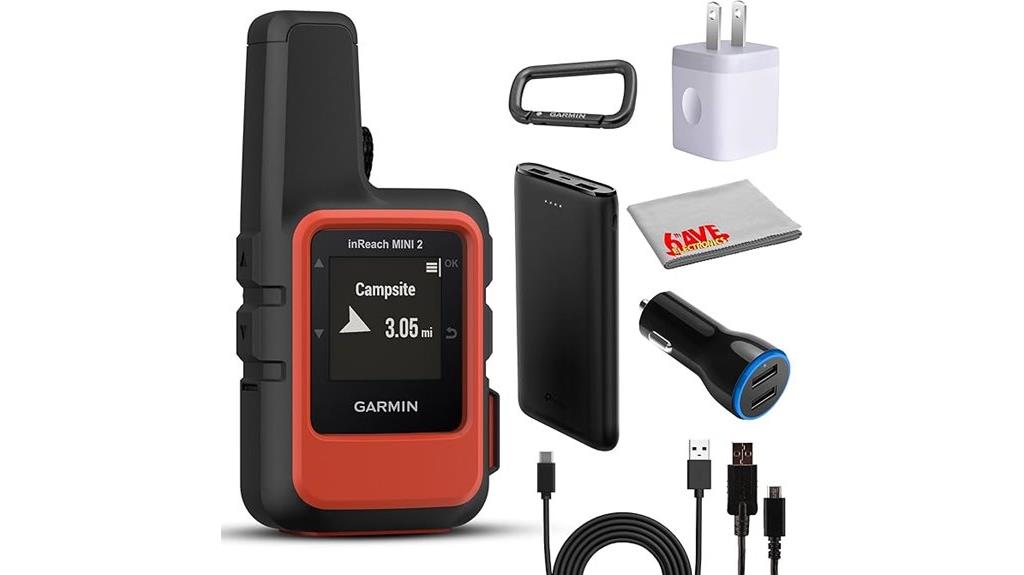
Looking for a satellite communicator that’s both lightweight and rugged enough for your outdoor adventures? The Garmin inReach Mini 2 fits the bill perfectly. Weighing just 3.5 ounces and built to MIL-STD-810 standards with IPX7 water resistance, it’s durable enough for harsh conditions. Its compact size makes it easy to carry on hikes, boat trips, or camping. It offers global coverage via the Iridium network, enabling two-way messaging, SOS alerts, and weather updates. The device’s long battery life, plus flexible subscription plans, ensures reliable communication during extended trips. Overall, it’s a compact, dependable safety tool for any outdoor enthusiast.
Best For: outdoor enthusiasts and adventurers who need reliable, portable satellite communication and safety features in remote areas.
Pros:
- Compact, lightweight design weighing only 3.5 ounces for easy portability
- Rugged build with MIL-STD-810 standards and IPX7 water resistance for durability in harsh environments
- Global coverage via Iridium network enabling reliable two-way messaging, SOS, and weather updates
Cons:
- Slightly higher cost compared to basic communication devices
- Requires a subscription plan for satellite service, which can add ongoing costs
- Small display may be less convenient for detailed navigation or information reading
Garmin inReach Messenger Plus SOS Satellite Communicator
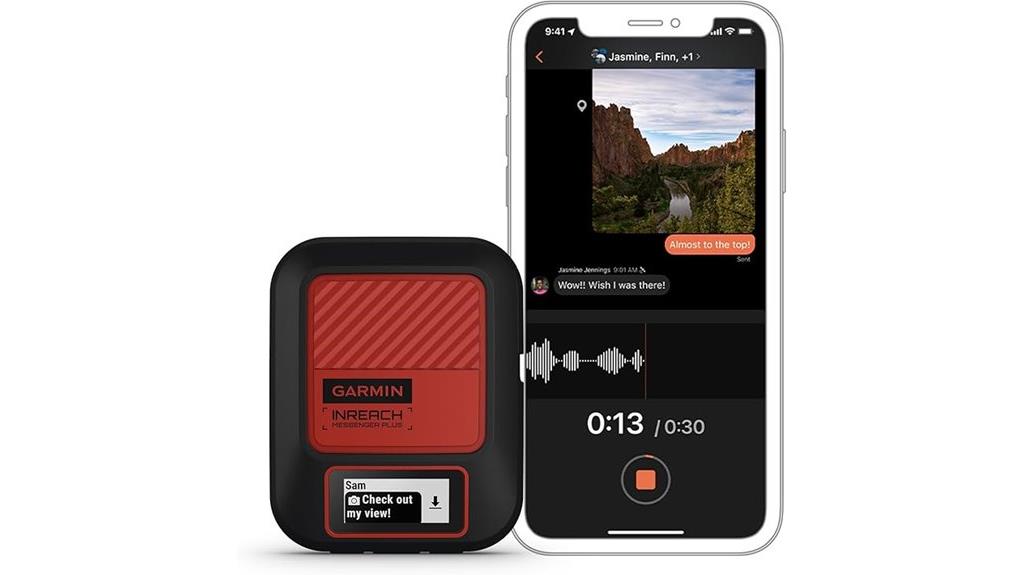
If you’re seeking a compact satellite communicator that combines reliable emergency features with versatile messaging options, Garmin inReach Messenger Plus SOS is an excellent choice. It supports two-way text, photo, and voice messaging without cell service, switching seamlessly between Wi-Fi, cellular, and satellite. The device features triggerable SOS messages to Garmin Response℠, ensuring help is always accessible. Its rugged, water-resistant design withstands tough conditions, and a rechargeable battery lasts up to 25 days in tracking mode. Paired with Garmin apps and compatible watches, it offers remote control and trip management. While subscription costs and limited screen size are considerations, its reliability in remote areas makes it a solid option.
Best For: outdoor enthusiasts, adventurers, and remote travelers needing reliable satellite communication and emergency SOS features.
Pros:
- Reliable two-way messaging, photo, and voice communication without cell service
- Rugged, water-resistant design suitable for harsh environments
- Long battery life of up to 25 days in tracking mode with emergency SOS capability
Cons:
- Requires an active subscription with recurring costs and initial activation fee
- Small display and navigation buttons can impact usability for some users
- Limited communication flexibility without a Garmin app contact or dedicated phone number
Garmin GPSMAP 67i Rugged GPS Handheld
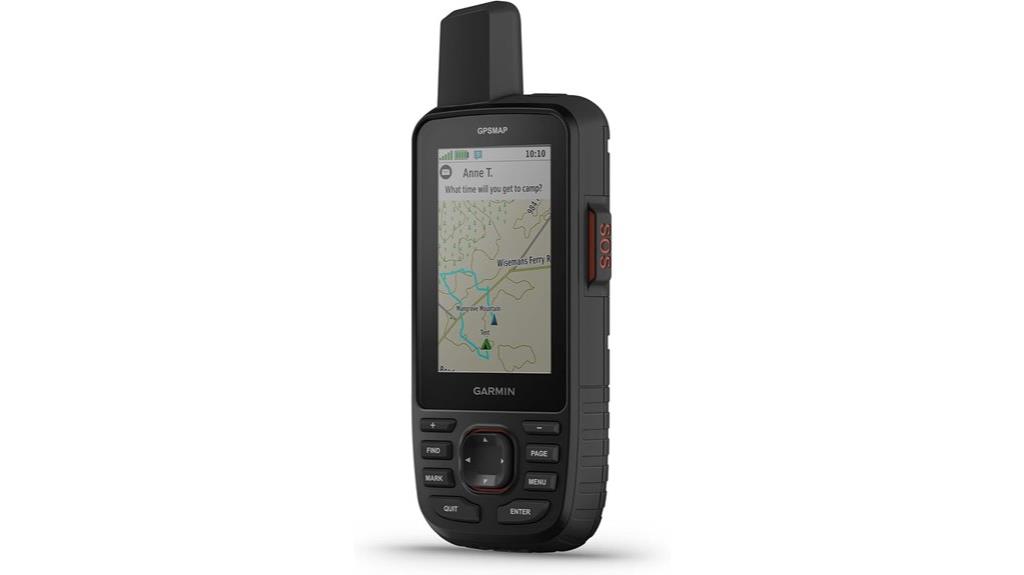
For outdoor enthusiasts who need reliable satellite communication and rugged navigation, the Garmin GPSMAP 67i Rugged Handheld stands out as a top choice. It combines GPS, satellite messaging, and detailed mapping on a bright 3-inch color display. Supports multi-band GNSS for precise positioning even in dense forests or remote locations. Its long battery life—up to 425 hours in expedition mode—ensures extended use. Built tough, it’s waterproof and impact-resistant, ready for harsh environments. Two-way messaging via Iridium satellite and an interactive SOS provide safety. Despite some software quirks and connectivity issues, its durability and extensive features make it a dependable tool for serious outdoor adventures.
Best For: outdoor enthusiasts and professionals who require rugged, reliable GPS navigation and satellite communication in remote or challenging environments.
Pros:
- Extremely long battery life up to 425 hours in expedition mode, suitable for extended trips
- Durable, waterproof, and impact-resistant design built to withstand harsh conditions
- Supports multi-band GNSS and detailed maps for accurate positioning and navigation
Cons:
- Complex user interface with a steep learning curve and multiple apps causing confusion
- Connectivity issues with Windows PCs, limiting map and route management options
- Heavier and larger than some users prefer for backpacking or extended carry
Garmin inReach Mini Satellite Communicator (Renewed)
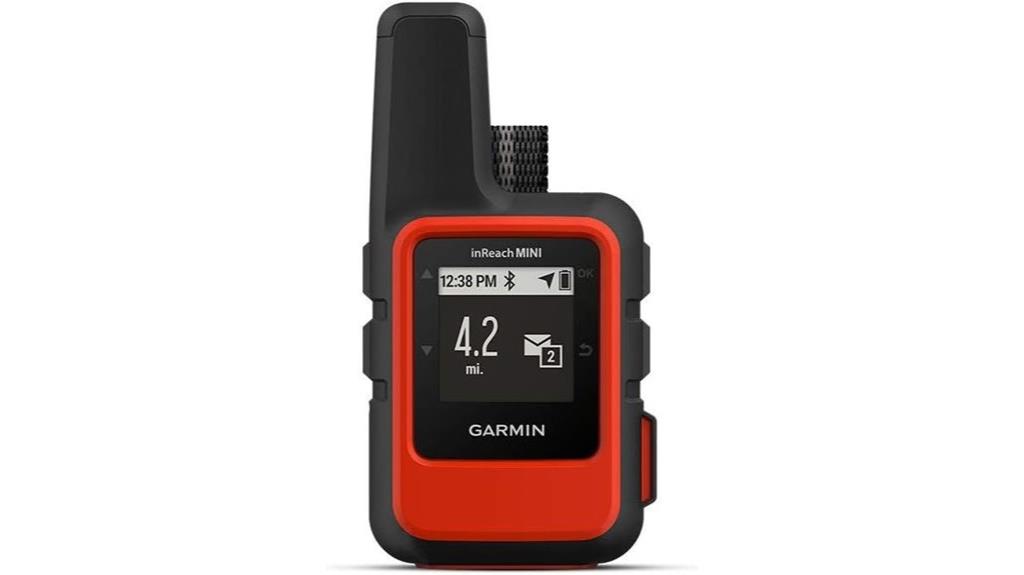
The Garmin inReach Mini Satellite Communicator (Renewed) stands out as an ideal choice for outdoor enthusiasts who need a compact, durable device to stay connected in remote areas. Its lightweight design makes it perfect for hiking, fishing, and boating, while its rugged build guarantees durability. It offers two-way messaging via the Iridium satellite network, an interactive SOS feature, and support for downloadable maps and NOAA charts through the Earthmate app. With a battery life of up to 24 days on two AA batteries, it’s reliable for extended trips. Though subscription costs apply, its safety features and ease of use make it a top option for remote connectivity.
Best For: outdoor enthusiasts seeking a compact, rugged satellite communicator for reliable remote messaging and safety in areas without cell service.
Pros:
- Lightweight, durable, and portable design ideal for outdoor activities like hiking, fishing, and boating
- Long battery life of up to 24 days with just two AA batteries, suitable for extended trips
- Supports two-way messaging, SOS emergency assistance, and downloadable maps via the Earthmate app
Cons:
- Requires a subscription for messaging, weather updates, and tracking features, adding ongoing costs
- Some users experience technical issues such as charging failures or firmware update challenges
- Trail tracking can incur additional costs and may not be easily reviewable after recording
OffGrid Satellite Communicator with Two-Way Messaging and SOS Alerts
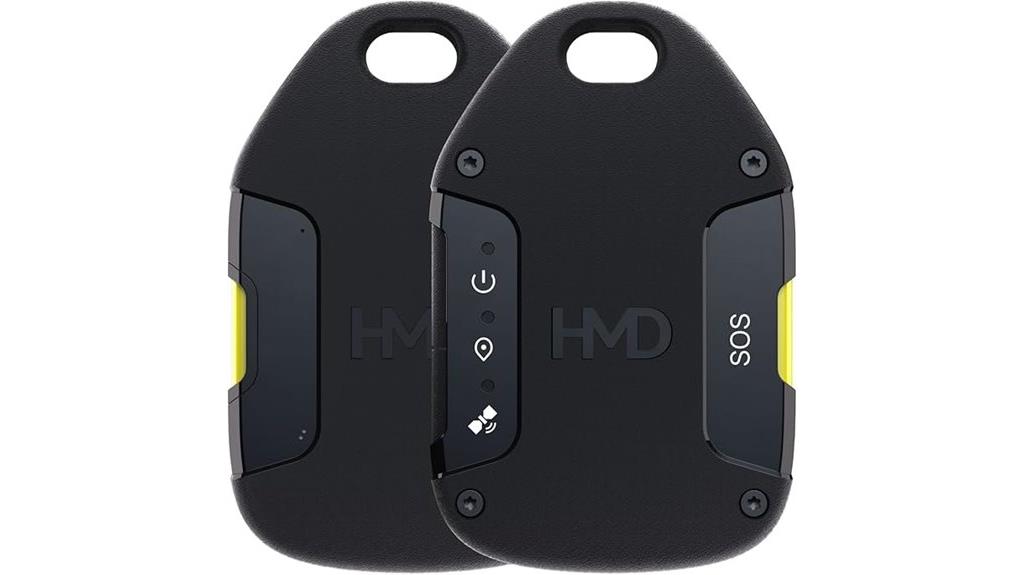
When exploring satellite communicators, the OffGrid device stands out for those who need reliable two-way messaging and emergency SOS alerts in remote areas. It offers real-time location sharing, allowing me to check in or alert loved ones if I’m in trouble. Built with military-grade durability, it’s waterproof and tough enough for harsh conditions. Connecting effortlessly to my smartphone via the OffGrid app, it’s easy to operate with simple physical buttons. Despite some mixed reviews on connectivity and support, its compact size, lightweight design, and long battery life make it a solid choice for outdoor adventures or remote work where traditional signals fail.
Best For: outdoor enthusiasts, remote workers, and adventurers who need reliable satellite communication, emergency SOS alerts, and real-time location sharing in areas without cellular coverage.
Pros:
- Durable, military-grade construction suitable for harsh environments
- Supports two-way messaging, SOS alerts, and real-time location sharing for safety and communication
- Compact, lightweight design with long battery life ideal for extended outdoor use
Cons:
- Mixed reviews regarding satellite connectivity and device reliability
- Support services have been criticized for slow response times and unresolved issues
- Potential issues with false advertising, incomplete deliveries, and inconsistent warranty support
Wearable4U Garmin inReach Mini 2 Satellite Communicator Bundle
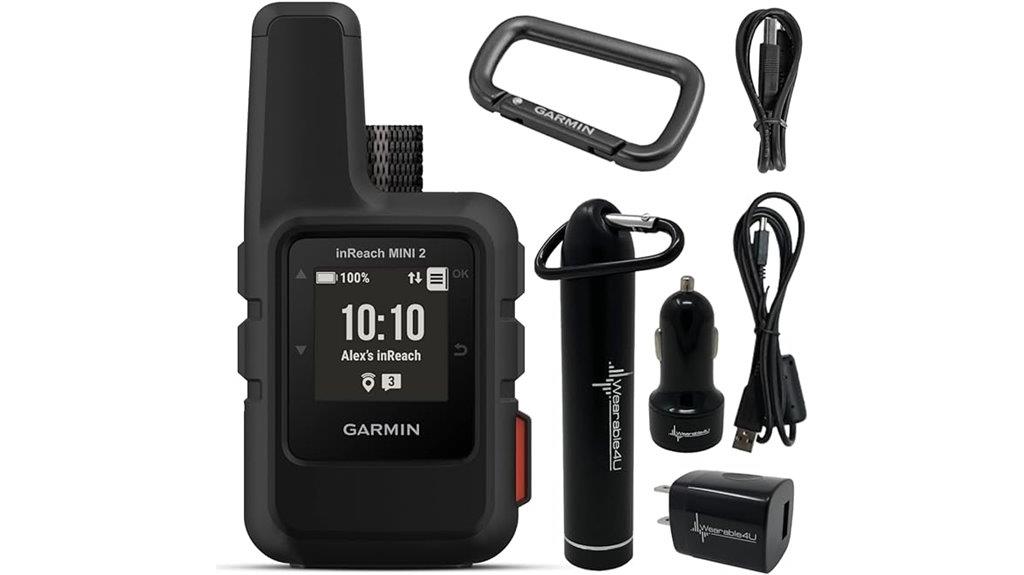
If you need a compact, reliable satellite communicator for remote adventures, the Wearable4U Garmin inReach Mini 2 Bundle stands out. It offers two-way messaging, interactive SOS globally, and TracBack routing for navigation. The device syncs with Garmin Explore for trip planning, mapping, and waypoints, making it versatile. Its digital compass provides accurate heading even when stationary. With up to 14 days of battery life in tracking mode, it’s perfect for extended trips. The bundle includes essential accessories like a power bank and chargers, ensuring continuous use. Its small size makes it easy to carry, and setup is straightforward, providing peace of mind in signal-deprived environments.
Best For: outdoor enthusiasts, hunters, and travelers who need reliable satellite communication and navigation in remote or signal-deprived environments.
Pros:
- Compact, lightweight design for easy portability
- Up to 14 days of battery life in tracking mode for extended use
- Syncs seamlessly with Garmin Explore for trip planning and mapping
Cons:
- Active satellite subscription required for full functionality
- Manual instructions could be more detailed for some users
- Battery drain may occur during prolonged use without power sources
Spot Gen 4 Satellite GPS Messenger

For outdoor enthusiasts who need reliable emergency communication in remote areas, the Spot Gen 4 Satellite GPS Messenger stands out as a top choice. This handheld device uses the Globalstar satellite network to send GPS coordinates and one-way messages, including SOS alerts. It’s rugged, lightweight, and easy to operate, with long-lasting batteries that last up to several months. Perfect for hiking, camping, or off-road adventures, it supports customizable messages and real-time location sharing. Users praise its reliability, quick message transmission, and simple design, making it an essential safety tool for staying connected and ensuring rescue in the most remote environments.
Best For: outdoor enthusiasts, hikers, and adventurers who need reliable satellite communication and emergency alerts in remote areas.
Pros:
- Rugged, durable design suitable for harsh outdoor environments
- Long-lasting batteries lasting several months with typical use
- Easy-to-operate with simple human interface buttons and quick message transmission
Cons:
- Limited to one-way messaging; no two-way communication feature
- Device may turn off after about an hour, requiring manual reactivation
- Basic mounting options; may need additional adhesives or mounts for secure placement
Factors to Consider When Choosing Satellite Communicators
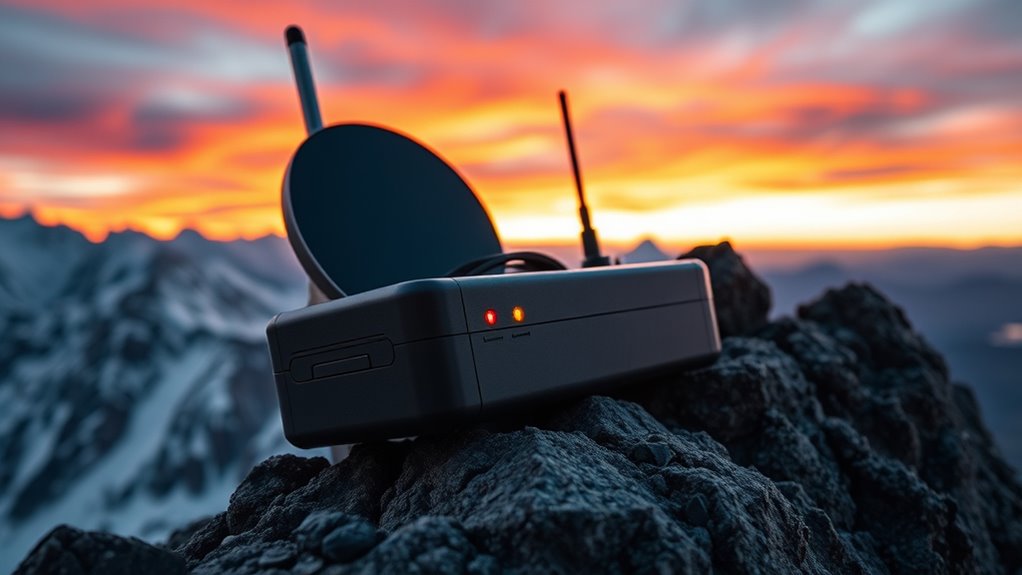
When selecting a satellite communicator, I focus on coverage and network compatibility to guarantee reliable service where I go. I also consider battery life and durability so my device lasts through long trips and tough conditions. Finally, I look at messaging features, emergency options, and costs to find the best fit for my needs and budget.
Coverage and Network Compatibility
Choosing the right satellite communicator depends heavily on understanding its coverage and network compatibility. Different networks like Iridium, Globalstar, and Thuraya offer varying global footprints. Iridium provides near-global coverage, including poles and oceans, making it perfect for remote or polar regions. In contrast, Globalstar’s coverage is limited in high-latitude areas and dense forests due to its satellite constellation design, which may affect connectivity. Compatibility with cellular, Wi-Fi, or Bluetooth networks also matters, as it influences how easily your device switches between satellite and terrestrial signals. It’s essential to check coverage maps for your typical travel routes and guarantee signal availability in those areas. This helps guarantee reliable communication when you need it most, regardless of location or network limitations.
Battery Life and Power
Long battery life is essential for outdoor adventures, ensuring your satellite communicator stays operational when you need it most. Some devices can last up to 200 hours on a single charge, which is perfect for extended trips. Keep in mind, active tracking and frequent messaging can drain batteries faster, so choose a model with efficient power management. Rechargeable lithium-ion batteries are generally better, offering faster charging and longer lifespan compared to disposable batteries. Power-saving features like cycling modes or adjustable tracking intervals help stretch battery life in remote areas. It’s also smart to select a device that supports external power sources, such as portable chargers or power banks, so you can keep your communicator running during longer adventures. This way, you stay connected no matter how remote your journey gets.
Device Durability and Design
Selecting a satellite communicator requires paying close attention to its durability and design, especially since outdoor adventures expose devices to tough conditions. I look for rugged, waterproof, and dustproof builds, often rated IP68 or higher, to guarantee resistance against water, dirt, and dust. A shock-resistant casing and reinforced materials are essential to withstand impacts and drops during hikes or climbs. Long-lasting batteries—over 200 hours of operation—are vital for extended remote use, so I prioritize devices with high-capacity power sources. Compact, lightweight designs also matter, making the device easier to carry without sacrificing durability. Finally, devices built to military-grade standards or tested against extreme temperatures, humidity, and water exposure give me confidence they’ll perform reliably in extreme environments.
Messaging and Emergency Features
Ever wonder how reliable your satellite communicator’s emergency and messaging features really are? The effectiveness hinges on how quickly and accurately they connect to rescue centers, especially during urgent situations. Look for devices with robust SOS functions that send precise location data instantly. Messaging options vary widely—some support two-way text, email, and preset messages, while others only send one-way alerts or limit characters. GPS location sharing and waypoint features are essential for real-time tracking, making rescue efforts faster and more precise. Additionally, check if the device offers offline maps or GPS navigation; these can be lifesavers in remote areas. Ultimately, understanding your subscription plan’s emergency and messaging services ensures you’re covered when it matters most, avoiding gaps in safety communication.
Subscription Plans and Costs
When choosing a satellite communicator, understanding the different subscription plans and their costs is crucial to ensuring you get the features you need without overspending. Plans typically range from around $7.99 to over $60 per month, depending on message allowances and features like GPS tracking or weather updates. Many devices require an active subscription for essential services such as two-way messaging, SOS alerts, and location sharing, with options for monthly or annual billing. If you’re infrequent user, some plans allow you to suspend or pause service, which can save money. Be aware that additional charges may apply for extra features or message overages. Carefully compare plans to match your usage and budget, ensuring you get the best value without paying for unnecessary extras.
Ease of Use and Setup
Choosing a satellite communicator that’s easy to use can make a big difference in how smoothly your adventures go. An intuitive interface with clear buttons and menus helps minimize setup time and reduces errors. Devices with straightforward pairing options, like Bluetooth or Wi-Fi, allow quick connections with smartphones or other devices, saving valuable time. Clear, detailed instructions and quick-start guides are essential for understanding initial setup and troubleshooting common issues. Additionally, easy subscription activation through mobile apps or web portals simplifies the process of enabling service plans. Features like preset messages, quick check-ins, or automatic location sharing further enhance ease of use by streamlining routine communications. Overall, a user-friendly device ensures you stay connected with minimal hassle, so you can focus on your adventure.
Frequently Asked Questions
What Are the Subscription Costs for Different Satellite Communicator Services?
You’re probably wondering about the costs of satellite communicator subscriptions. I’ve found that prices vary depending on the provider and plan. For example, some services start around $25-30 per month for basic plans, while premium options with global coverage and extra features can cost $50 or more. It’s best to compare providers, consider your usage needs, and look out for any hidden fees or discounts before committing.
How Long Do Battery Charges Last During Extended Use?
Did you know some satellite communicators can last over 200 hours on a single charge? During extended use, battery life varies by device and activity level. I’ve seen models that offer up to 100 hours with minimal activity, but intensive use, like sending messages or GPS tracking, can cut that down markedly. It’s essential to choose a device with a battery life that matches your adventure’s duration.
Are These Devices Compatible With All Smartphone Models?
You’re wondering if these satellite communicators work with all smartphone models. I’ve found that most devices are compatible with a wide range of smartphones, especially those with Bluetooth or USB connections. However, it’s always best to verify the specific device’s compatibility list before purchasing. I recommend verifying your phone’s specs and the communicator’s requirements to ensure seamless connectivity and avoid any surprises during use.
What Are the Warranty and Customer Support Options Available?
I believe that warranties and customer support are essential for satellite communicators. Most reputable brands offer warranties ranging from one to three years, covering manufacturing defects. They often provide dedicated customer support via phone, email, or live chat, ensuring quick resolutions. I’ve found that companies with strong support tend to stand behind their products, giving me peace of mind. It’s always smart to check individual brand policies before purchasing.
Can These Communicators Function in Extreme Weather Conditions?
You’re wondering if these satellite communicators can handle extreme weather conditions. From my experience, many top models are built with rugged durability, featuring waterproof, dustproof, and shock-resistant designs. They’re tested to perform in storms, heavy rain, snow, and high winds. While no device is entirely invincible, choosing a communicator with an IP rating and military-grade certifications gives me confidence it’ll work reliably, even in harsh weather.
Conclusion
Choosing the right satellite communicator can feel like searching for a needle in a haystack, but with these top options, reliable connectivity is within your grasp. Whether you’re adventuring off-grid or just want peace of mind, these devices are your trusted lifelines. Don’t settle for anything less—think of these communicators as your personal satellite superheroes, ready to save the day when you need them most. Stay connected, stay safe, and conquer the wild with confidence.
